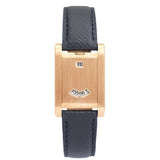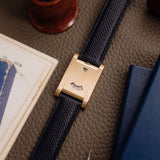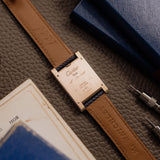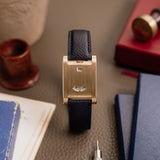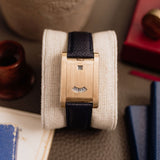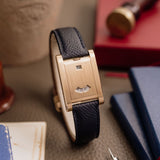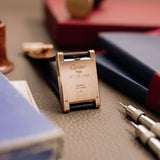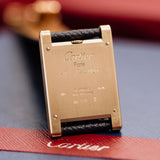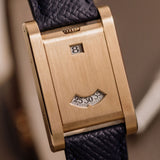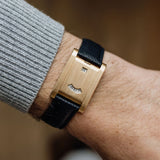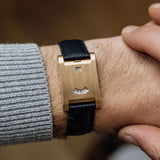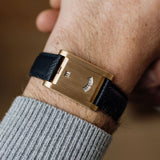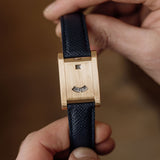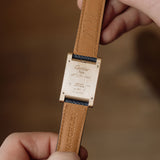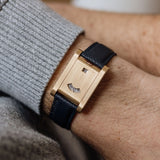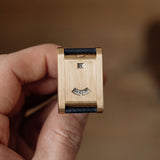Cartier Tank à Guichets - Pink gold - one of 3 from 1996
The Watch
One of just three. While the prevalence of limited editions has steadily increased over the past 30 years, to say it's uncommon for manufacturers to produce watches this limited, let alone for public sale, is quite an understatement. As watches from the 1990s move into the ‘neo-vintage’ spotlight and the conversation around collecting Cartier becomes hotter than ever, a memorable moment of the decade for Cartier connoisseurs was Antiquorum’s ‘Magical Art of Cartier Sale’. It’s here where Cartier produced one of its rarest versions of the Tank, the Guichets, in platinum, yellow, and pink gold. The kicker? They only made three examples of each metal – and this is one of those pink gold pieces.
The form of the Tank à Guichets is a little different from convention. The model measures 24mm wide by 35mm, with the brancards sitting flatter and squared off than a Tank Louis. As a result, its form is substantial and masculine as its pink gold realisation is predominantly vertically brushed. Aside from its more unique take on the Tank, the other major visual highlight is its crown situated at twelve. While there are documented examples of Guichets’ from the 1930s with crowns at three, this 1996 example is a re-issue of the model purchased by Maharajah of Patiala in 1928 with a central crown. Historical provenance aside, its placement is also wonderfully symmetrical.
As its name suggests, jump hours advance the hour metric via a revolving disk aperture, immediately snapping on the hour. The Guichets deploys a similar concept for the minutes, with an arc display integrating a pointed arrow aligning with the minute disk. Both mystical apertures are complemented by refined serif Arabic numerals, speaking closely to the era the original early examples were from.
Why The Tank à Guichets Is The Pinnacle Of Collectable Cartier
Now more than ever, Cartier has the eyes, ears, and wrists of the mainstream. The notion of collecting rare Cartier has moved from niche and quiet to expected and widespread. Notable cultural figures have been seen wearing the Tank and Crash while the brand’s modern CPCP collection continues to tastefully re-imagine treasures such as the Pebble, Normale, and Cintreé. These models undoubtedly carry importance, today achieving peaks never seen before in Cartier collecting, but some models out there still remain unobtainable; the 1996 Guichets’ sit in that category.
While pre-1970s Cartier are extremely collectable in their own right, recently we’ve seen important later models increase in popularity. The tail end of the 20th century saw Cartier ramp up its production as it chased a new wave of luxury, and while the popularity of the Santos and Panthere grew, the Maison didn’t lose sight of what made them who they are: a singular expression of elegance through uniquely shaped beautiful watches.
The catalyst for modern Cartier appreciation stems from one model; let’s talk about the Crash. Conceived in 1967 by Cartier London, the model arrived as a response to the changing spirit the decade embodied, with less than a couple of dozen examples believed to have left Cartier London’s doors at the time. It’s an expressive and artistic piece with a unique curvaceous case and stretched dial that resembles a melted standard Cartier. The model moved to Paris in the 1980s and '90s, with a well-documented run of 400 Paris editions in 1991 before taking a hiatus until the 2010s when it adopted diamonds and skeleton dials. In 2019, the Crash returned home to London in its traditional form, today it’s believed that approximately one Crash is made a month. It was around this time that pop culture flung the model into the limelight, and auction results followed suit, rising from low tens of thousands to $300,000 for a 1990s piece and a record-breaking $1.5 million for an early example. Today, the Crash remains a favourite of VIP Cartier clients, with images of special orders regularly shared online by clients. The reason for its allure? It is pure Cartier as the world recognises it, but its execution is totally individual. It’s slightly quirky but resolutely elegant from the masters of singularity.
Nevertheless, despite the charming mystifying allure of the Crash’s curves, with deep enough pockets, the watch is out there and available.
On the other hand, the Guichets is a different tale whose plot is centred around the truest definition of rarity. Pre-dating the Crash by 39 years, it’s believed that 15-20 of the original ‘Deux Guichets’ were produced between 1928-1931, with the model going 65 years before being seen again in 1996. As documented throughout this story, only 9 examples were created for the ‘Magical Art of Cartier Sale’ with the twelve o’clock crown, ahead of 150 three o’clock crown examples in platinum for their 150th anniversary in 1997. It was 2006 before the Guichets was seen again, only 100 were produced exclusively in pink gold, also with three o’clock crowns.
Combined with a rumoured piece unique in yellow gold and another in platinum, this brings the total production number of the Guichets over a 95-year time period to – at most – 281 examples. That’s around 70% of just the one run of Crash Paris 1991 models.
Eminent author, expert and collector of rare watches, John Goldberger, holds the largest privately owned collection of significant Cartier watches. “Compared to the Guichets, the amount of modern Crash examples is much higher, making the Guichets more collectable. He says. “It is a more classic model than the asymmetric non-conformism Crash and a big benefit in its favour is that it’s more traditionally unisex.”
“I’m a lucky owner of a platinum Tank à Guichet that I purchased during the Antiquorum auction in ‘96,” Goldberger shares. “The reason I bought it was because of its likeness to vintage examples and at the time I couldn’t find an original; nearly 30 years later I’m still searching for one!”
To fully comprehend the significance of the 1996 Guichets, let's dig into it a little more. Firstly, Cartier produced and sold these editions exclusively via auction. They weren’t reserved for clients nor sold before anyone knew of their existence, they were auctioned by Antiquorum on the open market.
The original auction estimates and results are as follows:
Platinum
Estimate: CHF 24,000 - 28,000
Achieved: CHF 87,100 (No. 1/3), CHF 67,000 (No. 2/3), CHF 108,000 (No. 3/3)
Yellow Gold
Estimate: CHF 14,000 - 16,000
Achieved: CHF 80,500 (No. 1/3), CHF 55,000 (No. 2/3), CHF 57,500 (No. 3/3)
Pink Gold
Estimate: CHF 15,000 - 18,000
Achieved: CHF 108,000 (No. 1/3), CHF 69,000 (No. 2/3), CHF 48,300 (No. 3/3)
“The numbers achieved by the 1996 Guichets are impressive considering during the auction, Cartier collectors like myself were actually more focused on many vintage watches in the catalogue”, recalls Goldberger.
Across the board, these results are very telling of the Guichets’ lore, but the most pertinent point we can decipher is how each of the nine watches blew past their estimates, at worst more than doubling the high estimates and at best, increasing them sixfold. Remember, this is in 1996, a time when Cartier connoisseurs were more focused on vintage pieces that were also available in the auction. Despite being distracted by originals, it’s evident that these watches have always been significant.
Goldberger is clearly still enamoured with his 1996 Guichets, as “even though it was designed almost a century ago, it is still a contemporary-looking wristwatch. I am very proud to still wear my platinum Guichets daily” he shares with us.
If there’s one thing to learn from trends is how susceptible they are to undulation. What’s hot today can swiftly become tomorrow’s old news. In our immediate world demand for certain watches can rise quickly – take the current rising interest surrounding the Baignoire or the rapid desire from collectors to own the Louis Vuitton Monterey II as living proof. But what’s immune to current crazes, remains constant and never fades are creations of true substance and scarcity. The 1996 Guichets models are incredibly special. They were always made to be so, representing the pinnacle of the emerging collectable Cartier world.
The Movement
Powering the Cartier Tank à Guichets is the 9752 MC mechanical jump hour calibre. Based on a Piaget ébauche, this 19-jewel movement is hand-wound and comes with beautifully decorated Cartier bridges, discreetly hidden behind the solid case back of this piece.
How It Wears
This Tank à Guichets is more in line with conventional sizes for classic Tanks. However, its wrist presence is still commanding, with chunky brancards and its lack of a conventional dial. On the wrist, it's quite possibly the most understated watch one could wear. Even to the untrained eye with its lack of Cartier branding, unusual crown placement and double aperture configuration, it's evident that there’s more of a story to this watch than meets the eye. It's a triumph in elegance and embodies the philosophy of tradition and unassuming sophistication.
Condition
This one of three Tank à Guichets in pink gold dates from 1996 and is available in great condition, displaying minimal hairline. Some oxidisation can be seen on the caseback and the included original Cartier deployant clasp. The watch is available fitted to a Custom Mr Watchley Grained Midnight blue Cartier strap.
Origin
While digital time displays were electrified with the dawn of LCD in the 1970s, numerical time readouts didn't wait for batteries and screens, with the jump hour complication being an early adopter. IWC's Pallweber of 1884 is the most celebrated, displaying the hours and minutes through separate dial apertures. Analogue hands were (and remain) the norm, but 40 years after the IWC, disks made it big time during the 1920s and ‘30s. With the watch having graduated from the pocket to the wrist, legacy manufacturers began producing jump hour watches, including Cartier.
The French Maison – now known the world over for its homogenised permanence and breadth of touch points – was firmly within the exclusive echelon of luxury during the early and mid-20th century, especially when it came to watches. For context, from 1919 - 1965, only 2,200 Cartier watches were ever produced. Today, it’s estimated that 600,000 watches are created annually. In 1928, they created their first jump hour, the Tank à Guichets. Known at the time as the ‘Deux à Guichets’ which translates to ‘two counters’, it's believed between 15-20 were made between 1928 and 1932. Cartier has only re-imagined the Tank à Guichets three times in the modern era, each time not exactly at scale. First, the 1996 run of nine examples that are distinguishable by their 12 o'clock crown and were evenly split across yellow gold, pink, and platinum. One year later for their 150th anniversary, they made 150 examples exclusively in platinum with a ruby cabochon crown at three. And in 2006, 100 pink gold examples debuted.
* Every watch is delivered in a Mr WATCHLEY Membrane Protection Box for a safe transportation in addition to its original set *
If you desire to take a closer look at this precious timepiece, don't hesitate to contact us and make an appointment. We are based in Ghent, Belgium
No stock kept on site
| Reference | Tank à Guichets |
|---|---|
| Movement | Manual Wound |
| Caliber |
Calibre 9752 MC
|
| Dial | Guichets |
| Size (Case) | 35 mm x 24 mm |
| Material (Case) | Pink gold |
| Bracelet | Mr Watchley Custom Cartier Strap |
| Buckle |
Cartier pink gold folding buckle |
| Condition | Very good |
| Year | 1996 |
| Papers | - |
| Box | - |
| Warranty | 2 years |

